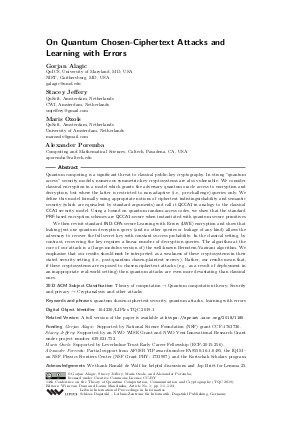@InProceedings{alagic_et_al:LIPIcs.TQC.2019.1,
author = {Alagic, Gorjan and Jeffery, Stacey and Ozols, Maris and Poremba, Alexander},
title = {{On Quantum Chosen-Ciphertext Attacks and Learning with Errors}},
booktitle = {14th Conference on the Theory of Quantum Computation, Communication and Cryptography (TQC 2019)},
pages = {1:1--1:23},
series = {Leibniz International Proceedings in Informatics (LIPIcs)},
ISBN = {978-3-95977-112-2},
ISSN = {1868-8969},
year = {2019},
volume = {135},
editor = {van Dam, Wim and Man\v{c}inska, Laura},
publisher = {Schloss Dagstuhl -- Leibniz-Zentrum f{\"u}r Informatik},
address = {Dagstuhl, Germany},
URL = {https://drops.dagstuhl.de/entities/document/10.4230/LIPIcs.TQC.2019.1},
URN = {urn:nbn:de:0030-drops-103939},
doi = {10.4230/LIPIcs.TQC.2019.1},
annote = {Keywords: quantum chosen-ciphertext security, quantum attacks, learning with errors}
}

 Creative Commons Attribution 3.0 Unported license
Creative Commons Attribution 3.0 Unported license


